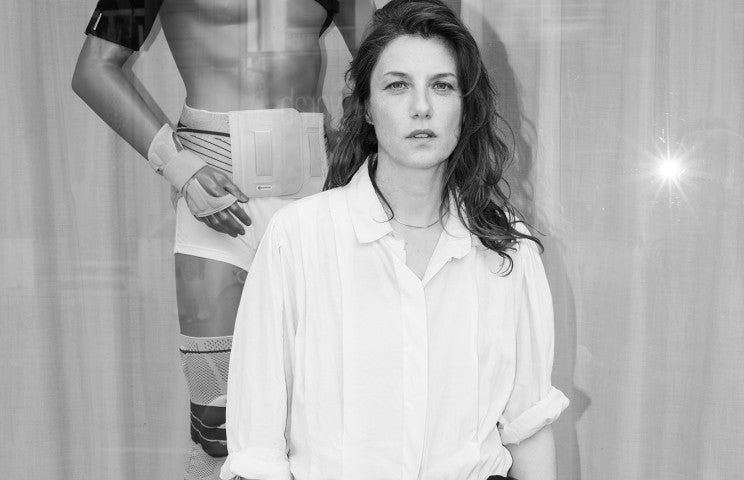Postposer la performance
Conferences directed by Jérôme Mauche : watch the video of the meeting !
These days, efforts to preserve the records of performance art are under way, as is the circulation of its history through a variety of channels. Contemporary performance is also part of a regime of generalized performativity that characterizes many aspects of society and goes beyond aesthetic questions to encompass the world of labor, sports, affects…
This event in the Poetry Platform series proposes to identify more precisely what performance has changed and how its influence is still being felt in bodies, discursive regimes and frameworks of reference. It features a dialogue between Esther Ferrer, an figure of performance, active in Spain and France since the 1960s, and Marie de Brugerolle, an art historian and exhibition curator who reflects on what post-performance could be.
There is no forgetfulness or nostalgia in the approaches of these two authors, each of whom is a practitioner and theoretician in her own way. Their approaches may instead be defined by the sharpness of their vision and their ability to challenge themselves, as they elaborate grammars and experiment with the syntaxes of performance.
BIOGRAPHIES
Marie de BRUGEROLLE
Art historian and exhibition curator Marie de Brugerolle is a specialist of performance and its history, from its early period in the 1960s (particularly in California) to its dematerialization and absorption in the society of spectacle in the twenty-first century.
The many exhibitions she has organized to date include “Where’s Al?” (on Allen Ruppersberg), which she co-designed with Paul McCarthy at the CNAC-Le Magasin in 1996; “Who’s That Guy?” (a retrospective of Guy de Cointet’s work, whose rediscovery she decisively contributed to), presented at the MAMCO in Geneva in 2004; “Faire des choses avec des mots/Making Words With Things” (Cointet, Mc Carthy, Kelley, Sullivan) at the CRAC in Sète (2006);
“From Life” and “Larry Bell in Perspective,” the first French retrospectives of
John Baldessari and Larry Bell, both presented at the Carré d’art in Nîmes
(in 2005 and 2010, respectively); and “Not to Play with Dead Things” at
the Villa Arson in Nice (2008).
Marie de Brugerolle also works on the issue of revival and recently helped present Guy de Cointet’s last play Five Sisters (1982) at the LACMA and at the MoMA. She is the author of many articles and several books, including Premières critiques (Les Presses du Réel, 2010) and Guy de Cointet, portrait de l’artiste en cryptographe (JRP Ringier, 2011).
Following the latest exhibitions she has designed, “I was a Male Yvonne de Carlo” (with Dora Garcia) at the MUSAC de Leon and “L.A. EXISTANCIAL” at the LACE in Los Angeles, de Brugerolle is currently at work with Gérard Wajcman on the 2014 exhibition “ALL THAT FALLS !!!” for the Palais de Tokyo. She is also preparing an anthology of Andrea Fraser’s writings for Les Presses du Réel and co-translating (with Julien Bismuth) Jack Spicer’s plays for the stage and the radio, which will be published by Petits Matins. Marie de Brugerolle is a professor at the ENSBA in Lyons and a guest lecturer at the HEAD in Geneva.
Esther FERRER
A major figure of performance and action art, Esther Ferrer was a member of the Spanish group ZAJ from 1967 on, together with musicians Juan Hidalgo and Walter Marchetti. In her collaborations with ZAJ, whose aesthetic was close to that of Fluxus, but also individually, Ferrer developed a keenly subtle plastic work mainly oriented towards ephemeral action. Her work, which consists in an experience and art of time, space and presence, was then representative of a minimalism “based on the rigor of the absurd,” in her own words. At the time, she was also involved the organization in Spain (with painter José Antonio Sistiaga) of a “workshop for free expression” based on Freinet’s pedagogy.
Her important activity as a performer earned her a reputation in Europe as well as North and South America: as early as 1968 her work was presented simultaneously at the Centre Culturel Amigos del País in Bilbao, at the Musée d’Art Moderne de la Ville de Paris, at the Rudolf Zwirner gallery in Cologne or in Düsseldorf on the initiative of Jörg Immendorf. Around the same time, from the 1970s on, Esther Ferrer started making series of photographs, installations, objects, sketches involving mathematics, an example of which is “The Poem of Prime Numbers” (1985). Her practice may also be situated in the proximity of visual and sound poetry (including the POLYPHONIX festival) and has led her to intervene in countless events in contemporary art, performance and poetry around the world.
Esther Ferrer represented Spain at the 1999 Venice biennale. In Spain, she received the Premio Nacional de Bellas Artes in 2008 and the Premio Gure Artea in 2012. After important monographic exhibitions in Spain, Italy and Brazil over the past few years, the first retrospective of Ferrer’s work in France took place this year at the FRAC Bretagne on the initiative of Marion Daniel (the second part will be presented in February 2014 at the MAC/VAL in Vitry).








